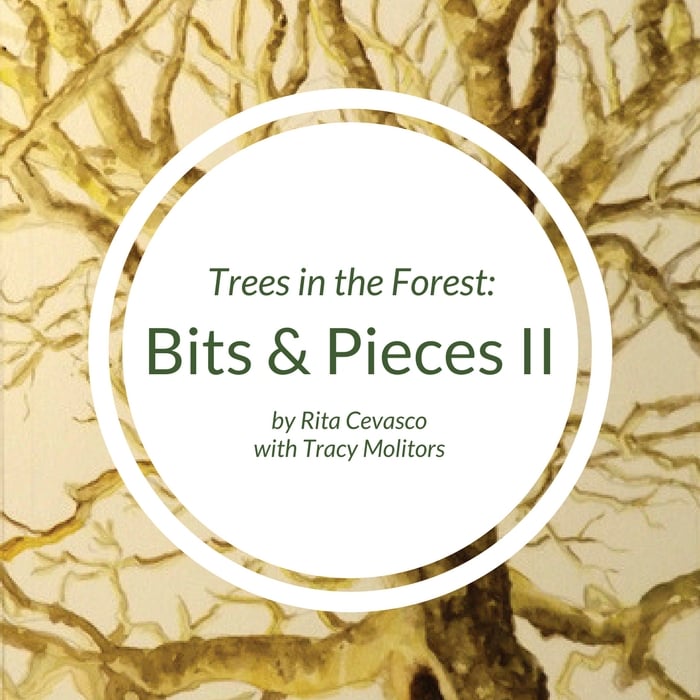Trees in the Forest: Day Three

by Rita Cevasco and Tracy Molitors
Day One: Laying a Path
Day Two: Bits & Pieces I
“In light of having a very reluctant, older, dysgraphic child, I appreciate the information surrounding ways to entice, encourage, inspire, appreciate, and respect where he is at and where he hopes to go—even when he doesn’t have the faith that he can get there.” —Tara, Homeschool Parent
Bits and Pieces. Every bit of writing lays a stone on the path to more elaborate writing. Each word on paper is a necessary ingredient to helping a reader and writer see that they can write. Blank pages are intimidating, so filling a page with drawings surrounded by Bits and Pieces of writing is a means of Laying a Path. Stones are small steps, so we write in defined boxes and circles to encourage children to take another step. We respect each child’s current ability level, luring kids along with tender encouragement and care. Bits and Pieces of writing is a necessary ingredient for the struggling learner who needs even more encouragement and tinier steps.
Bits and Pieces of writing is good for all of us. All readers and writers, whether they struggle or not, grasp a story on a surface level, yet must grow in deeper understanding to comprehend below the surface of a story. Deep comprehension requires us to interpret not only how a character acts, but why a character acts or thinks a certain way. Not only what a story is about, but why a story is being told. Cartooning characters with Bits and Pieces of writing encourages all of us to answer why questions.
Today we are going to continue to add Bits and Pieces of writing to our character cartoon. Each day, each Bit will help our children elaborate on their understanding of both the character and the story’s meaning. Each Piece will help them get their words on paper.
No matter the age, kids can engage in some level of interpretation about what their character wants and what stands in the character’s way. This is known as conflict. As we engage in this activity with our children, we will notice that having general ideas about how a character thinks is far less demanding than writing what a character is thinking. Writing even a simple sentence requires us to capture our stray ideas and formulate them into one cogent thought.
By putting pen to paper, our children can see their thoughts in a new way. Written words are not fleeting: they remain in place and in time, giving children an opportunity to ponder. When re-reading our own words, our ideas are magnified, so our understanding solidifies. I have had students exclaim, “Oh, I get it!” after seeing their own words on paper. It seems that speaking our thoughts helps focus our lens, writing our thoughts brings a closer focus, then rereading our writing magnifies our ideas! Written interpretation has the power to deepen our comprehension and then inspire further insight.
Today our children will write in Bits and Pieces about their character’s conflict. We do this by taking on the character’s perspective and voice. We must think about the entire story, then converge on one single idea: “My character wants to . . .” In this way, we begin to identify the character’s conflict: what our character desires versus what or who stands in our character’s way. When you are done with today’s writing, have each family member read aloud what they have written; notice whether today’s writing leads our children to deeper insight and discussion about their character.
If you haven’t already, download Cartooning Characters to see how we encourage children to interpret their character’s problem. You will receive a packet that contains a blank drawing sheet, five days’ worth of activities labeled Day One through Day Five (each adding to the original drawing), and an example of Tracy’s completed cartoon for your reference.
We are on Day Three of the activity, so be sure to work up to that day. Tomorrow, we will give you insight into Day Four’s strategy. Each day we will give you insights into how and why the next step matters, so be sure to read along throughout the week. Spreading cartooning over many days allows us to revisit our character, each day digging deeper into our thoughts and writing a bit more.
DOWNLOAD Cartooning Characters
Trees in the Forest: Growing Readers and Writers through Deep Comprehension
by Rita Cevasco with Tracy Molitors
Think deeply to write deeply. . . Geared to parents, educators and Speech Language Pathologists, this creative resource can be used to aid children in becoming lifelong readers and writers. Available in PDF or PRINT formats.
For the digital PDF version:
Take $5.00 off at check out!
Enter Discount Code: RITA5
(expires January 31, 2017)
[This post contains an Amazon affiliate link. When you click on the link to make a purchase,
Brave Writer receives compensation at no extra cost to you. Thank you!]
Live with Rita!
 If you’ve been thinking of joining The Homeschool Alliance now would be a great time! Rita Cevasco will hold a LIVE web conference for Homeschool Alliance members Thursday, January 12th, from 4:00-6:00 PM EST!
If you’ve been thinking of joining The Homeschool Alliance now would be a great time! Rita Cevasco will hold a LIVE web conference for Homeschool Alliance members Thursday, January 12th, from 4:00-6:00 PM EST!

















